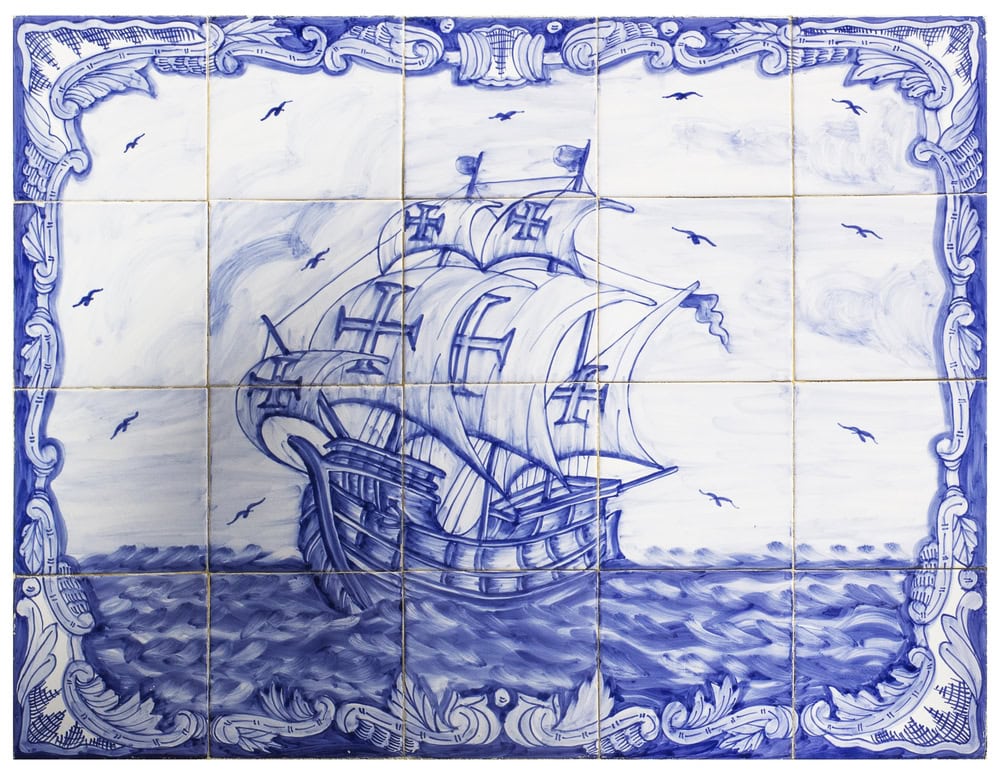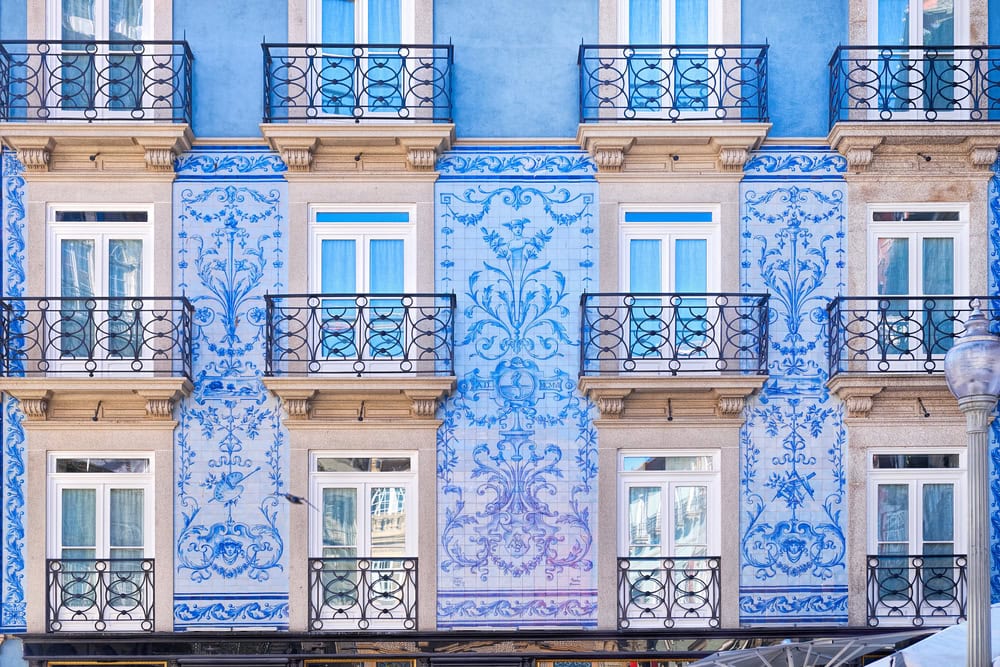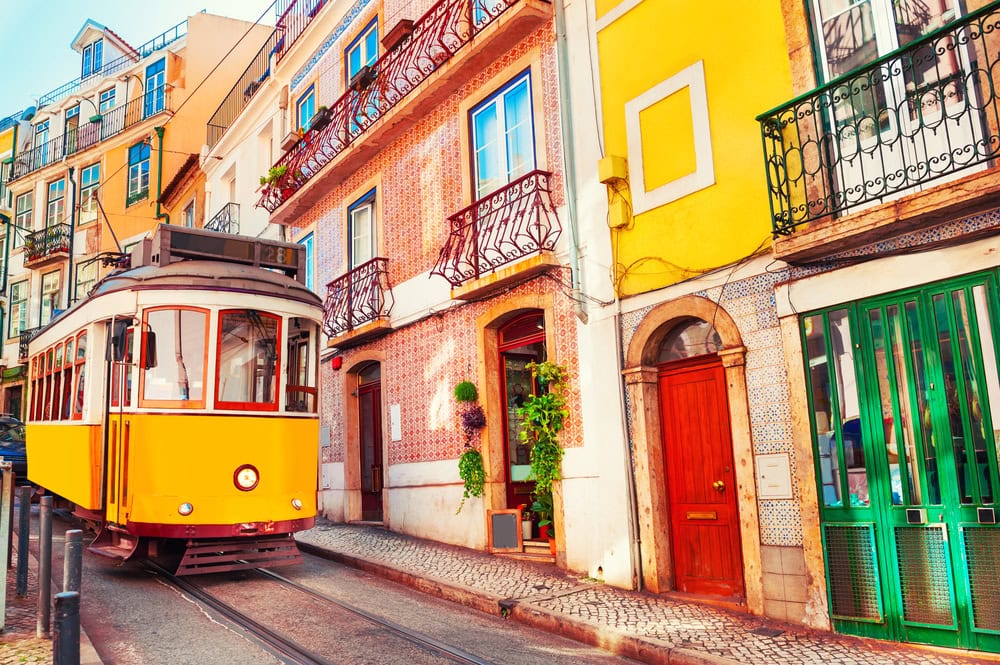Wander most any street in Portugal, and you’ll see azulejos tiles, those decorative blue tiles on buildings, churches, and homes. At first glance, they seem merely decorative, but a closer look reveals artistic storytelling — a majestic sailing ship navigating the seas, a biblical scene, a marketplace depicting every day life.

These are azulejos, Portugal’s hand-painted tiles that have been decorating buildings and telling stories for centuries. It’s a look at Portugal’s rich history and culture, waiting to be explored by curious travelers.
Let’s learn more.
- History of Azulejos Tiles
- What is the Cultural Importance of Azulejos Tiles to Portugal?
- How Are Azulejos Tiles Made?
- How Long Does it Take to Make Azulejos Tiles?
- Can Azulejos Tiles be Customized?
- How To Take Care of Azulejos Tiles?
- Azulejos Tile Patterns and Their Meanings
- Where to Buy Modern Azulejos Tiles
- Exploring Artistic Azulejos Murals
- For Pinterest
History of Azulejos Tiles
The history of Azulejos tiles is one of cultural exchange and creative progress, rooted in Spanish and Portuguese heritage. The term “Azulejos” is derived from the Arabic word “azulejo,” which means “small polished stone,” referring to the skilled craftsmanship and mosaic-like quality of the Portuguese tiles.
Portugal’s landscape retains traces of several civilizations and cultures, from the Celtic and Iberian tribes’ early settlements to the Roman conquest and Moorish rule. It wasn’t until the medieval period that Portugal began to establish its own identity, eventually emerging as a global maritime power during the Age of Discovery.
The origin of Portuguese azulejos date back to the 14th century when it emerged as a form of ceramic art on the Iberian Peninsula. Initially inspired by North African mosaics, Azulejos tiles evolved to incorporate indigenous influences, becoming a symbol of Spanish and Portuguese architectural expression.
During the several centuries of Moorish rule on the Iberian Peninsula, the art of glazed ceramic tiles flourished. The Moors developed a methodology for producing bright patterns and geometric designs that were then assembled into scenes to decorate palaces, mosques, and public areas. The combination of detailed craftsmanship and vibrant colors soon made them highly sought after.
Following the Reconquista, when Christian forces regained expelled Muslim forces and regained control of the Iberian Peninsula, the art of Azulejos continued to thrive and adapt. Portuguese artisans, in particular, started to add their own style to Azulejos tiles, drawing inspiration from Moorish designs while adding indigenous motifs and themes. This combination gave rise to a distinctive Portuguese Azulejos tradition that adorned churches, monasteries, and royal residences.
Today, Azulejos traditional handcraft processes continue, but technological developments have broadened the possibilities for Azulejos design, allowing for greater freedom and expression. Mass production of the art form has also resulted in replicas of the patterned tiles becoming more commoditized.
What is the Cultural Importance of Azulejos Tiles to Portugal?
The Portuguese Age of Discovery, led by daring explorers such as Vasco da Gama and Ferdinand Magellan, began an era of cultural exchange and trade. As ships set sail to various lands, they carried not only goods and riches but also ideas, art, and influences that would shape Portugal’s artistic landscape. With this exploration and cultural connection, the art of Azulejos tiles emerged. Influenced by Moorish techniques and designs, Portuguese artists began creating ceramic tiles with vibrant colors and detailed patterns. While they were initially used to decorate palaces, churches, and public buildings, they quickly became a symbol of Portuguese architecture and were adopted on a more wide-scale basis.
Aside from their decorative purposes, Azulejos tiles also have practical functions that contribute to the architectural landscape of Portugal. The tiles serve as insulation and protection from the elements, helping to regulate temperature and humidity, and enhancing the comfort and durability of buildings. Traveling around Portugal, you’ll see them in sacred spaces, palaces, and everyday locations like restaurants, subways stops, and train stations.
Azulejos tiles have also found their place in private homes. Handmade pieces might add some artistic pop to interior walls, mass produced tiles are often used to create a house number on the exterior of a building, and contemporary artists are creating new designs and ways of incorporating the tile work into home decor.
How Are Azulejos Tiles Made?
The process of making Azulejos tiles is precise and detailed, starting with the careful selection of basic materials such as clay, silica, feldspar, and pigments. These components are combined with water to make a workable paste called slip, which is then poured into molds to create the desired tile shapes and sizes.
After molding, the tiles are slowly dried to prevent cracking and warping. After drying, artists create detailed patterns and designs by hand using special brushes and pigments. Following decoration, the tiles are coated with a layer of glaze to enhance their appearance and protect the surface.
Lastly, the tiles are fired in a kiln at high temperatures to vitrify the clay and activate the pigments in the glaze, resulting in vibrant colors and a glossy finish. Throughout the process, strict quality control measures ensure that each tile meets the highest standards of production, ensuring their durability. Voila – the plain white tiles are transformed into works of art.
If you gone to a local painting pottery or ceramic studio, you’ll have an idea of the process.
The mass production of azulejo tiles short circuit the process at every step. The tiles are formed by an automated process, designs are stamped onto the tiles, and then they head for firing. Reproductions like this are all that’s going to fit in my shopping budget, but I appreciate the fine craftsmanship provided by artisans making them by hand.

How Long Does it Take to Make Azulejos Tiles?
The time required to produce Azulejos tiles will vary based on factors such as the complexity of the design, the size of the tiles, and the drying and firing processes. Generally, it can take several days to weeks from the initial molding to the final firing in the kiln.
Of course, the commercialized product is made much more quickly.
Can Azulejos Tiles be Customized?
Yes, many tile manufacturers and artisans offer customization options, allowing customers to create personalized designs for their Azulejos tiles. This may involve collaborating with designers to develop unique patterns or incorporating specific motifs requested by the customer.
This can be a time consuming process, from concept to finished product, so time and patience are required. When completed, however, you’ll own an original masterpiece.
How To Take Care of Azulejos Tiles?
Azulejos tiles are typically low-maintenance, requiring only periodic cleaning to remove dirt, dust, and grime. Depending on their location and exposure to environmental factors, tiles installed outdoors may need more frequent cleaning to maintain their appearance. Additionally, grout lines between tiles may need to be periodically resealed to prevent moisture penetration and staining.
You’ll often see large tile installations being cleaned as you wander around Portugal.
Azulejos Tile Patterns and Their Meanings
Known for their detailed patterns and vibrant colors, the tiles have cultural and historical importance in Portugal. Here are a few patterns and they symbolism and significance.
- Geometric Patterns: Azulejos tiles often include geometric designs like arabesques, stars, and interlocking shapes. These patterns often symbolize harmony, unity, and the interconnectedness of life. They reflect the Islamic influence on Portuguese art and architecture during the Moorish rule of the Iberian Peninsula.
- Floral Designs: Floral patterns are another common theme in Azulejos tiles, with motifs inspired by nature including flowers, vines, and leaves. These patterns represent growth, life, and the beauty of the natural world. They also portray concepts of renewal and regeneration, which represent Portugal’s landscapes and agricultural history.
- Maritime Motifs: Given Portugal’s deep-rooted maritime history, many Azulejos tiles feature motifs related to the sea, including ships, anchors, and sea creatures. These patterns honor Portugal’s seafaring heritage, celebrating exploration, trade, and adventure.
- Religious Imagery: Azulejos tiles often represent religious scenes and symbols, showcasing motifs such as saints, angels, and religious icons. These patterns reflect Portugal’s strong Catholic traditions and serve as expressions of faith and devotion. They adorn churches, monasteries, and religious institutions.
- Historical Narratives: Some Azulejos tiles symbolize historical events, battles, and cultural narratives. These patterns serve as visual representations of important moments in history, commemorating achievements, struggles, and triumphs.
Where to Buy Modern Azulejos Tiles
Studios and boutiques around Portugal sell tiles to visitors. Tiles basically come in two sizes, the small size at 3×3 and the large size at 6×6. Individual tiles can be used in home decor (backsplashes, trim, trivets), or combined with other tiles to create a large installation. Prices for an individual tile can range from five dollars to many hundreds.
Some studios are retail outlets only, others offer personalize tours, and some have classes so you can give the art form a try. I took a tile art class about six years ago. While I’m no Picasso, it was a fun experience and i still have – and use – the tile (as a coaster).
Avalon Waterways’ Douro River cruise offers a tile painting class as part of their program.
Some popular studios include:
- Fabrica de Sant’anna in Lisbon dates back to 1741 and offers traditional hand-painted tiles and ceramics, along with custom one-of-a-kind pieces.
- Viuva Lamego in Sintra offers trend-driven tiles suitable for various projects, from walls to restaurants. The company dates back to 1849.
- Ceramica S. Vincente in Castelo offers the works of artist Cristina pina, and also has classes in her studio.
- Loja dos Descobrimentos in the Alfama neighborhood of Lisbon is both a shop and studio space.
The concierge at your hotel should be able to help you find an art-quality azulejos studio in the city your are visiting.
If you are looking for an inexpensive gift, mass produced azulejos can be found in most souvenir shops around the major cities. These obviously cost less, but understand that they are printed rather than hand painted. Nothing wrong with that, just know what your buying.
And if you get home from your trip to Portugal and have regrets about not buying a tile while there, you can purchase reproductions of vintage azulejos at home.

Exploring Artistic Azulejos Murals
As you’re exploring any city in Portugal, keep an eye out for azulejos murals. You really can’t miss them.
To get you started, here are some must-see spots to admire stunning Azulejos murals:
- São Vicente de Fora Monastery (Lisbon) – The São Vicente de Fora Monastery features stunning Azulejos panels portraying Portuguese history and religious themes. With origins dating back to the 12th century, this historic site is not only a testament to Portuguese craftsmanship but also a significant landmark housing the tombs of royalty and nobility.
- National Tile Museum (Lisbon) – The National Tile Museum, housed in the old Madre de Deus Convent, has an extensive collection of Azulejos tiles spanning centuries. Here, visitors can marvel at artistic murals representing diverse styles and techniques, providing a look into the evolution of Azulejos artistry in Portugal.
- São Bento Railway Station (Porto) – One of Porto’s most iconic landmarks, São Bento Railway Station is known for its stunning Azulejos panels. The station’s main hall is decorated with murals portraying scenes from Portuguese history and daily life.
- Capela das Almas (Porto) – Capela das Almas, located in Porto’s historic center, is a small chapel decorated with Azulejos murals portraying religious themes and events from Saint Catherine’s life.
Disclosure: My trip to Portugal was sponsored by Avalon Waterways. This post contains affiliate links.
For Pinterest
Pin to save your favorite Pinterest boards







